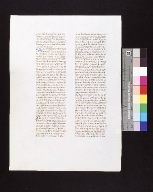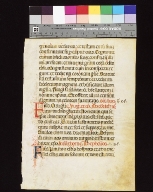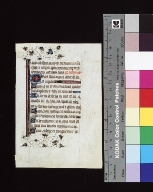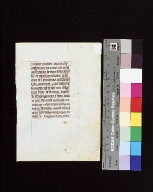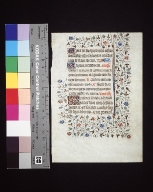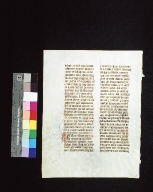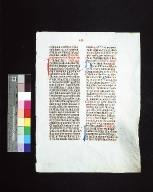|
REFINE
Browse All : Manuscripts, Medieval and manuscript (documents) and books and still image from 1450 approximate
1-12 of 12
Title
Ab urbe condita: fragment
Creator
Livy
Summary
[Ms. This manuscript leaf is part of a collection of medieval manuscript leaves selected to illustrate the art of the manuscript during the period of its greatest development and influence. They have been taken from books written in various European scriptoria by Benedictine, Franciscan, Carthusian, Dominican, and other orders of monks. Many are enriched with handsome borders, initial letters, and line-endings rendered in color. Twenty-five are illuminated with burnished gold or silver. The texts include the Bible, various church service books, the writings of the Church fathers, and some of the Classics., In Humanistic script., The known part of Livy's great life work, the History of Rome, was completed about the year 9 A.D. The finished work consisted of one hundred and forty-two books, of which only thirty-five are extant. These books are regarded as one of the most precious remains of Latin literature. One of the outstanding characteristics of the scholars and scribes of the Italian Renaissance was their great interest in Latin literature. Through their influence, many copies of the classics were made from the few 9th and 10th century manuscripts available. These earlier manuscripts had been written in a carolingian or pre-gothic script to which the 15th century humanistic calligraphers assigned the name antiqua littera. The letters were not really of antiquity, since minuscule letters were not known before the time of Charlemagne. In the 15th century, this carolingian script became the inspiration not only for manuscripts like this leaf, but also for the fine roman types designed by the printers in Italy. This vellum leaf was created in Italy.]
Title
Contra Jovinianum: fragment
Creator
Jerome, Saint, d. 419 or 20
Summary
[Ms. This manuscript leaf is part of a collection of medieval manuscript leaves selected to illustrate the art of the manuscript during the period of its greatest development and influence. They have been taken from books written in various European scriptoria by Benedictine, Franciscan, Carthusian, Dominican, and other orders of monks. Many are enriched with handsome borders, initial letters, and line-endings rendered in color. Twenty-five are illuminated with burnished gold or silver. The texts include the Bible, various church service books, the writings of the Church fathers, and some of the Classics., In letter de somme, Jerome, the father of the Latin Church and translator of the Bible, shows in his writing his active participation in the controversies of his day (c. 332 to 420 A.D.). With the frequent use of vehement invective, he is often as biting as Juvenal or Martial. This fine book hand, lettre de somme, obtained its name from the fact that Fust and Schoeffer used a type based on it for the printing of their Summa Theologica of St. Thomas Aquinas in 1467. It was the favorite manuscript book hand in the second half of the 15th century for the transcribing of French chronicles and romances. Simplicity and dignity are maintained by omitting all enrichment around the burnished gold letters. The first printed books followed the practice seen here of marking off by hand and with a stroke of red the capitals at the beginning of each sentence. Fifteenth century ink frequently had a tendency to fade to a gray tone as in this example. This vellum leaf was created in France.]
Title
Epistolarium: fragment
Creator
Catholic Church
Summary
[Ms. This manuscript leaf is part of a collection of medieval manuscript leaves selected to illustrate the art of the manuscript during the period of its greatest development and influence. They have been taken from books written in various European scriptoria by Benedictine, Franciscan, Carthusian, Dominican, and other orders of monks. Many are enriched with handsome borders, initial letters, and line-endings rendered in color, and twenty-five are illuminated with burnished gold or silver. The texts include the Bible, various church service books, the writings of the Church fathers, and some of the Classics., Written in Rotunda or Round Gothic Script, square rehtorical neumes, Epistolaries are among the rarest of liturgical manuscripts. Their text consists of the Epistles and Gospels with lessons from the Old Testament for particular occasions. Sometimes, as in this leaf, they had interlinear neumes in red to assist the deacon or sub-deacon in chanting parts of this section of the church service while he was standing on the second step in front of the altar. The text is written in well-executed rotunda gothic script with bold Lombardic initials. Some of the filigree decoration which surrounds the initial letters has faded because it was executed in some of the fugitive colors which were then prepared from the juices of such flowers and plants as tumeric, saffron, lilies, and prugnameroli (buckthorn berries). This vellum leaf was created in mid-fifteenth century Italy.]
Title
Graduale: fragment
Creator
Catholic Church
Summary
[Ms. This manuscript leaf is part of a collection of medieval manuscript leaves selected to illustrate the art of the manuscript during the period of its greatest development and influence. They have been taken from books written in various European scriptoria by Benedictine, Franciscan, Carthusian, Dominican, and other orders of monks. Many are enriched with handsome borders, initial letters, and line-endings rendered in color. Twenty-five are illuminated with burnished gold or silver. The texts include the Bible, various church service books, the writings of the Church fathers, and some of the Classics., In rotunda gothic script, A Gradual contains the appropriate antiphons of a mass sung by the choir of the Latin Church on Sundays and special holidays. The text was furnished largely by the 150 Psalms and the Canticles of the Old and New Testaments. The superb example of calligraphy in this leaf illustrates the supremacy of the Italian scribes of the time over those of the rest of Europe. It is frequently assumed that this late revival of fine writing may have been caused by the concern of scribes over the impending competition with the newly invented art of printing. The music staff still retains here the early 12th century form with the C-line colored yellow and the F-line red. The four-line red staff had been in use for over two centuries before this manuscript was written. This leaf was created in Italy.]
Title
Horae Beatae Mariae Virginis: fragment
Creator
Catholic Church
Summary
[Ms. This manuscript leaf is part of a collection of medieval manuscript leaves selected to illustrate the art of the manuscript during the period of its greatest development and influence. They have been taken from books written in various European scriptoria by Benedictine, Franciscan, Carthusian, Dominican, and other orders of monks. Many are enriched with handsome borders, initial letters, and line-endings rendered in color. Twenty-five are illuminated with burnished gold or silver. The texts include the Bible, various church service books, the writings of the Church fathers, and some of the Classics., In angular gothic script, This Book of Hours shows definite characteristics of the manuscript art of France and the Netherlands of about 1450 A.D. It was probably one of many copies prepared for sale at a shrine to which devout pilgrims came to worship or to seek a cure. The spiked letters and the detached ornamental bar are unmistakably Flemish in spirit, while the free ivy sprays are distinctively French. The burnished metal in the decorations shows the use of alloyed gold (oro di metà) as well as silver. Various metals were added in different localities to the fine gold. English illuminations frequently had a decided orange hue, while the French had a lemon cast. The quality of the gold was best enhanced by the use of burnishing tools equipped with an emerald, a topaz, or a ruby. Less successful burnishers contained an agate or the tooth of a wolf, a horse, or a dog. This vellum leaf was created in Northern France.]
Title
Horae Beatae Mariae Virginis: fragment
Creator
Catholic Church
Summary
[Ms. This manuscript leaf is part of a collection of medieval manuscript leaves selected to illustrate the art of the manuscript during the period of its greatest development and influence. They have been taken from books written in various European scriptoria by Benedictine, Franciscan, Carthusian, Dominican, and other orders of monks. Many are enriched with handsome borders, initial letters, and line-endings rendered in color. Twenty-five are illuminated with burnished gold or silver. The texts include the Bible, various church service books, the writings of the Church fathers, and some of the Classics., In angular gothic script, It is generally no great task to assign these illuminated Books of Hours to a particular country or period. The treatment of the ivy spray with the single line stem and rather sparse foliage is characteristic of the work of the French monastic scribes about the year 1450 A.D. The occasional appearance of the strawberry indicates that the illuminating was done by a Benedictine monk. Fifty years earlier the stem would have been wider and colored, and the foliage rich; fifty years later the ivy and holly leaves would be entangled with flowers and acanthus foliage. This vellum leaf was created in France.]
Title
Horae Beatae Mariae Virginis: fragment
Creator
Catholic Church
Summary
[Ms. This manuscript leaf is part of a collection of medieval manuscript leaves selected to illustrate the art of the manuscript during the period of its greatest development and influence. They have been taken from books written in various European scriptoria by Benedictine, Franciscan, Carthusian, Dominican, and other orders of monks. Many are enriched with handsome borders, initial letters, and line-endings rendered in color. Twenty-five are illuminated with burnished gold or silver. The texts include the Bible, various church service books, the writings of the Church fathers, and some of the Classics., In angular gothic script, The text of a Book of Hours consists of Gospels of the Nativity, prayers for the Canonical Hours, the Penitential Psalms, the Litany, and other prayers. The beauty of the rich borders found in some of these books frequently claims our attention more than the text. In these borders it is easy to recognize the ivy leaf and the holly, but is usually more difficult to identify the daisy, thistle, cornbottle, and wild stock. The monks had no hesitancy in letting these flowers grow from a common stem. Because of the translucency of vellum, the flowers, stems, and leaves of the border were carefully superimposed on the reverse side in order to avoid a blurred effect. This vellum leaf was created in France.]
Title
Horae Beatae Mariae Virginis: fragment
Creator
Catholic Church
Summary
[Ms. This manuscript leaf is part of a collection of medieval manuscript leaves selected to illustrate the art of the manuscript during the period of its greatest development and influence. They have been taken from books written in various European scriptoria by Benedictine, Franciscan, Carthusian, Dominican, and other orders of monks. Many are enriched with handsome borders, initial letters, and line-endings rendered in color. Twenty-five are illuminated with burnished gold or silver. The texts include the Bible, various church service books, the writings of the Church fathers, and some of the Classics., In angular gothic script, Books of Hours, beautifully written, enriched with burnished gold initials, and adorned with miniature paintings, were frequently the most treasured possessions of the devout and wealthy layman. They were not only carried to chapel but were often kept at the bedside at night. Oaths were sworn on them. Books of this small size, two and one-half by three and one-half inches, are comparatively rare. The craftsmanship in this example imitates and equals that in a volume of ordinary size, about five by seven inches. Recently these small "pocket" editions have been given the nickname "baby manuscripts." In general, the miniature Books of Hours contain only that section of the complete volume which deals with the prayers to be read or recited at the canonical hours; namely, matins, vespers, nocturns, and those for the prime, tierce, sext, nones, and complin. Indulgences were often granted for the faithful reading or recitation of these prayers. This vellum leaf was created in France.]
Title
Horae Beatae Mariae Virginis: fragment
Summary
[Ms. This manuscript leaf is part of a collection of medieval manuscript leaves selected to illustrate the art of the manuscript during the period of its greatest development and influence. They have been taken from books written in various European scriptoria by Benedictine, Franciscan, Carthusian, Dominican, and other orders of monks. Many are enriched with handsome borders, initial letters, and line-endings rendered in color. Twenty-five are illuminated with burnished gold or silver. The texts include the Bible, various church service books, the writings of the Church fathers, and some of the Classics., In angular gothic script, In the second half of the 15th century, the devout and wealthy laymen had a wide selection of Books of Hours from which to choose, both manuscript volumes and printed texts. These were often sold, in large cities, in book stalls erected directly in front of the main entrance to the cathedral. The first printed and illustrated Book of Hours appeared in 1486. It was a crude work, but later noted printers such as Verard, Du Pre, Pigouchet, and Kerver issued in great numbers Books of Hours with numerous illustrations and rich borders. The decorations were frequently hand colored and further embellished with touches of gold. These Books of Hours created a strong competition for the more costly manuscript copies. Customers who still preferred the manuscript format and could afford it also had a choice of many different types of decoration and could stipulate what quantity and quality of miniatures they desired. By this time the ivy spray had a variety of forms. It might be seen springing from an initial letter, from the end of a detached bar, in a separate panel in company with realistic flowers, or forming a three- or four-sided border intermixed with acanthus leaves and even birds, animals, and hybrid monsters which are neither man nor beast. This vellum leaf was created in France.]
Title
Missale Lemovicense Castrense: fragment
Creator
Catholic Church
Summary
[Ms. This manuscript leaf is part of a collection of medieval manuscript leaves selected to illustrate the art of the manuscript during the period of its greatest development and influence. They have been taken from books written in various European scriptoria by Benedictine, Franciscan, Carthusian, Dominican, and other orders of monks. Many are enriched with handsome borders, initial letters, and line-endings rendered in color. Twenty-five are illuminated with burnished gold or silver. The texts include the Bible, various church service books, the writings of the Church fathers, and some of the Classics., In angular gothic script, The provenance of this manuscript is clearly designated as Limoges because of the inclusion of certain parts of the masses proper to this diocese, and because of the resence of the coat of arms and obituary records of the noted e Rupe family of that city. Frequently, without such data, it ould be impossible to determine whether a fragment written in his period and country was from Amiens, Dijon, or Limoges. The national book hand had become amazingly uniform. In this manuscript as in many manuscripts of the 15th century there is an increasing tendency to speed and slackness. France was no longer setting the standard for manuscripts. This example shows that they were greatly influenced by contemporary Italian manuscripts.]
Title
Missale: fragment
Creator
Catholic Church
Summary
[Ms. This manuscript leaf is part of a collection of medieval manuscript leaves selected to illustrate the art of the manuscript during the period of its greatest development and influence. They have been taken from books written in various European scriptoria by Benedictine, Franciscan, Carthusian, Dominican, and other orders of monks. Many are enriched with handsome borders, initial letters, and line-endings rendered in color. Twenty-five are illuminated with burnished gold or silver. The texts include the Bible, various church service books, the writings of the Church fathers, and some of the Classics., In angular gothic script, The Missal, written for the convenience of the priests, combined the separate books formerly used in different parts of the service; namely, the Oratorium, Lectionarium, Evangeliarium, Canon, and others. Gutenberg, who printed his famous First Bible about the time this manuscript was written, based his type designs on a contemporary book hand similar to this example. The craftsmen who created this manuscript had the difficult problem of evolving a harmonious page with two sizes of writing, inserted rubrics, and large and small colored initials. The smaller writing is used for the Orationes, the Psalms, the Secreta, and other parts of the service; the larger script or the Sequentia.]
Title
Psalterium: fragment
Creator
Catholic Church
Summary
[Ms. This manuscript leaf is part of a collection of medieval manuscript leaves selected to illustrate the art of the manuscript during the period of its greatest development and influence. They have been taken from books written in various European scriptoria by Benedictine, Franciscan, Carthusian, Dominican, and other orders of monks. Many are enriched with handsome borders, initial letters, and line-endings rendered in color. Twenty-five are illuminated with burnished gold or silver. The texts include the Bible, various church service books, the writings of the Church fathers, and some of the Classics., In Rotunda book hand; square notations, This Psalter was written by Carthusian monks. Of all the orders in the Carthusian was the smallest and most austere. The membership never exceeded one per cent of those enrolled in the combined monastic orders. The Carthusians were frequently hermits, and manuscripts written by them are rare. The rotunda book hand used in this leaf is representative of the general excellence maintained by Italian scribes at the time when printing was being introduced into their country. The simple melody for the Psalms apparently was added at a somewhat later date. Close observation of the initial letters will frequently reveal a small black letter inserted as a guide for the monk who later added the color initial. The use of two guide lines for the lettering is unusual. Ordinarily one line, below the writing, was deemed sufficient. The lines were drawn with a stylus composed of two parts lead and one part tin. This leaf was created in Italy.]
1-12 of 12
|

